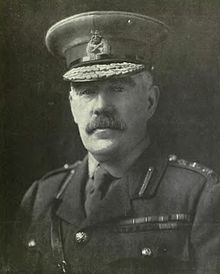William Robertson - Picture
More about World War 1

|
|
William Robertson
Sir William Robertson, Bt
Nickname: "Wully"
Place of birth: Welbourn, Lincolnshire
Place of death: London
Allegiance: United Kingdom
Service/branch: British Army
Years of service: 1877-1920
Rank: Field Marshal
Battles/wars: Chitral Expedition
Second Boer War
World War I
Awards: Knight Grand Cross of the Order of the Bath
Knight Grand Cross of the Order of St Michael and St George
Knight Grand Cross of the Royal Victorian Order
Distinguished Service Order
Field Marshal Sir William Robert Robertson, 1st Baronet, GCB, GCMG, GCVO, DSO (29 January 1860 - 12 February 1933) was a British officer who served as Chief of the Imperial General Staff (CIGS) from 1916 to 1918 during the First World War. He was the first British Army soldier to rise from private soldier to field marshal.
Early life
"Wully" Robertson was born at Welbourn, Lincolnshire. Educated at the local church school, he began his military career in 1877 by enlisting as a private in the 16th (The Queen's) Lancers. At that time, the army was seen by many people as a refuge of last resort for paupers and 'ne'r do wells'. His mother was horrified. "I will name it to no one," he records her saying in his autobiography, "I would rather bury you than see you in a red coat."
He rose to sergeant major in 1885, his career being helped by a developing expertise in signalling and quartermasters' duties. Encouraged by his officers (and the clergyman of his old parish) he passed an examination for officer status and obtained a commission as a lieutenant in the 3rd Dragoon Guards. This was very unusual at the time. Those who had exceptional skills in supporting services were sometimes promoted to officer rank in the engineers or similar corps, but Robertson was commissioned as a cavalry officer. It would have been impossible for this to happen in Britain, as officers were expected to have a private income that would enable them to 'keep up appearances' and pay extravagant mess bills. In India, it was different. Active service officers with experience were needed, there was less accent upon social status and appearance, and the cost of living was very cheap.
He consequently served in India and completed a tour of duty with the Intelligence Corps. He was wounded and awarded the DSO in the Chitral relief expedition. Promoted to captain, he attended Staff College at Camberley in 1896-97. Attendance at the Staff College indicated that he had been selected as an intelligent and promising officer, and graduates of the College were earmarked for 'fast track' promotion, capable of commanding military formations. He was the first former ranker to attend Staff College.
Boer War and Staff College
With the start of the Second Boer War, Robertson was appointed as Intelligence officer to Frederick Roberts, 1st Earl Roberts, the British Commander-in-Chief South Africa, subsequently returning to the War Office to head the foreign section of the intelligence department. He was later commandant of the British Army Staff College.
World War I

Picture - Robertson, 1917
Following the outbreak of World War I, Robertson served as Quartermaster General and then as Chief of Staff of the British Expeditionary Force (under John French) before being promoted to Chief of the Imperial General Staff in December 1915. As CIGS, Robertson was a strong supporter of BEF commander Douglas Haig, and played a major role in the ousting of Prime Minister Herbert Henry Asquith and his replacement with a Tory-dominated coalition led by David Lloyd George. He was committed to a Western Front strategy focusing on Germany and against what he saw as peripheral operations on other fronts. This stance was at odds with Lloyd George's view that Britain's war effort ought to be focused on the other theatres until the arrival of sufficient US troops on the Western Front, and Robertson resigned as CIGS in February 1918. He then became General Officer Commanding-in-Chief of Eastern Command. After the armistice, he commanded the British Army of the Rhine.
In 1919, Robertson was thanked by Parliament, granted £10,000 and created a Baronet, of Beaconsfield in the County of Buckingham. When he was promoted to field marshal a year later, he became the first man to rise in the British army from the lowest rank (private) to the highest (field marshal).
Robertson died in February, 1933, aged 73. He was succeeded in the baronetcy by his son Brian Hubert. The latter rose to become a general in the Army and was raised to the peerage as Baron Robertson of Oakridge in 1961.
Legacy
Mount Robertson in the Canadian Rockies is named for him, and Sir William Robertson High School in his birth village, Welbourn, is named after him.
Further reading
The Military Correspondence of Field-Marshal Sir William Robertson, Chief Imperial General Staff December 1915-February 1918 Woodward, David R (ed.) Bodley Head for ARS, 1989
The British Field Marshals 1736-1997, Tony Heathcote, Pen & Sword Books Ltd, 1999, ISBN 0-85052-696-5
Robertson, Sir William Robert, From Private to Field Marshall, London: Constable, 1921
David R Woodward, "Sir William Robertson and Sir Douglas Haig", Chapter 5 of "Haig, a re-appraisal 80 years on", edited by Brian Bond & Nigel Cave. Pen & Sword Military, Barnsley, 2009. ISBN 9781844158874
More aircraft.
Source: WikiPedia